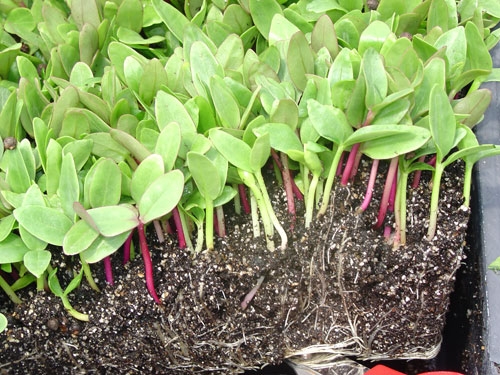Another way to engage the family in sustainable living and healthy eating is by starting a table-top farm at home. Growing sprouts has been popular for decades. Today, microgreens are the new hot topic.
Microgreens are larger than sprouts, but smaller than baby salad greens. They are found in trendy restaurants and gourmet grocery stores, but can easily be grown anywhere with sufficient light, says Marin County UC Master Gardener Dot Zanotti Ingels. Harvested at about two inches tall, they add texture and flavor to salads and sandwiches, can be mixed into dips, used as a garnish and sprinkled on top of pizza.
“Children like microgreens because they are fast growing with quick rewards,” she said. “Nutritionally, microgreens are loaded with vitamins, minerals, enzymes and phytonutrients.”
To grow microgreens, all you need are containers, soil, seeds and water.
“I like to use attractive containers or small pots to keep my growing area fun to look at, but containers could be recycled plastic food trays or a wide, shallow flower pot,” Ingels said.
She suggests the following steps:
- Fill the container with moistened fresh potting mix or seed starting mix to one-inch of the top. Another option is using soilless germinating media, such as a growing mat, peat, vermiculite, perlite or coconut fiber.
- Sprinkle seeds evenly to cover one-third to one-half of the soil or growing media surface (buying bulk seeds online will save money).
- Top the seeds with a thin layer of soil and tamp down lightly.
- Water with a spray bottle, keeping the soil as moist as a wrung-out sponge.
- Start with or without a clear cover; once seeds have germinated, keep the container open.
- Harvest when the first true leaves appear by snipping with sharp kitchen shears. Seedling to harvest varies from 7 to 21 days.
Chia, cress, mustard greens, radish and arugula are just a few of the varieties used to grow microgreens. Pam Geisel, the academic coordinator of the UC Master Gardener program, suggests trying borage, basil, cilantro and other leafy herbs. A good plant to try first is broccoli, since it tends to be reliable in germination and a strong sprout in the first crucial days.
To ensure success and food safety, Geisel recommends microgreen growers compost the old soil or growing medium and start over new with each planting.
“When reusing soils, there can be a problem with damping off and other organisms, such as salmonella,” Geisel said. Damping off is the term used for fungus-caused ailments that kill seeds or seedlings. “Microgreens don’t have a lot of roots so the soil or mats have to be watered often but not kept soggy wet. I would not use the greens if there is any sign of mold or decay.”
Attached Images:
